There are so many fantastic trekking opportunities in Ladakh, attracting mountain enthusiasts and adventure seekers from all over the world. From short and easy hikes to challenging treks, there are options suitable for all fitness levels and experience.
Here are the top 10 trek itineraries to do in Ladakh.
1. Markha Valley Trek
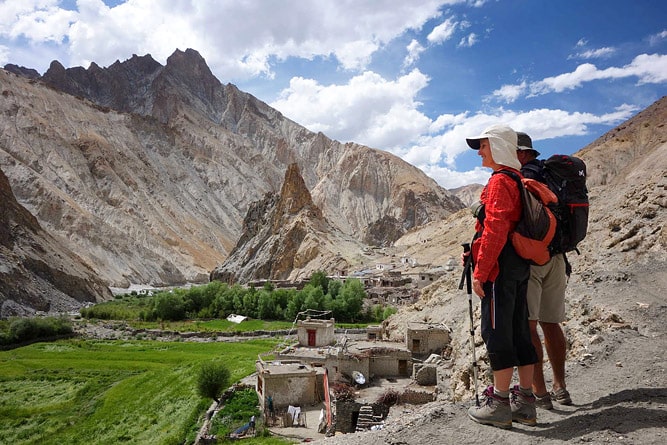
The Markha valley trek is Ladakh’s most popular trekking route. During this trek, you can admire wonderful Himalayan landscapes and discover the authentic local village life. The Markha valley is part of the Hemis National Park so it is also a great place to observe wildlife.
The trek starts from Chilling, the entry point of the Hemis National Park, at the bridge crossing the Zanskar river. During the first 4 days, the trail follows the Markha valley and passes through numerous villages (Skiu, Sara, Markha, Hankar) where trekkers can stay overnight in homestays. Staying in homestays is a wonderful opportunity to discover the Ladakhi culture and local food.
At the end of the 4th day, you will reach Nimaling at an altitude of 4,840m where you will have to camp because there is no village in the remote area. The next day, you will cross the spectacular Kongmaru La, the highest pass on this trek at an altitude of 5,260m. From the pass, it is a steady descent to Shang Sumdo. On the 6th day, you will reach Hemis, the end point of this wonderful trek. You can visit Hemis monastery before heading back to Leh by car.
Duration:
6 days
Level:
moderate
Max. altitude:
5,260m (at Kongmaru La)
Distance:
78 km
Best time:
May to October
Itinerary:
Chilling - Skiu - Markha - Hankar - Shang Sumdo - Hemis
Transportation before and after the trek:
- Leh to Chilling
- Hemis to Leh
2. Rumtse to Tso Moriri Trek
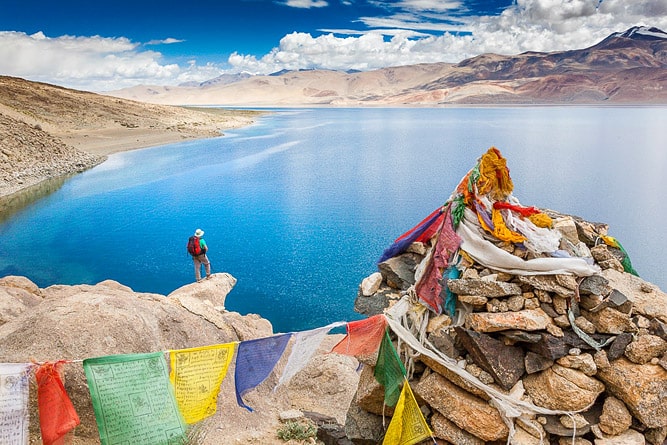
The trek from Rumtse to Tso Moriri lake, also known as the Rupshu trek, is one of the most beautiful treks in the whole Himalayan region. During this 7-day trek, you will cross the Changthang region and get to admire the stunning landscapes of the Tibetan plateau. You will discover two high-altitude lakes: Tso Kar lake where you might spot the majestic black-necked crane and other rare birds, and the magnificent Tso Moriri lake which is the end point of the trek.
The trek from Rumtse to Tso Moriri takes you to remote areas where you will not find any villages for days. Therefore, you will need to carry tents and bring food supplies from Leh. If you are lucky, you may come across Changpa nomads who inhabit the region with their yaks and pashmina goats. Before starting the trek, you will need to get a special permit in order to access this part of Ladakh.
This trek is rated as difficult due to its average altitude always above 4,500m and because it crosses six mountain passes above 5,000m. When you reach Tso Moriri lake on the 7th day, you should spend the night in Korzok and the taxi will take you back from Korzok to Leh on the next day. Indeed, it is better to have some time to relax at the lake before driving back to Leh.
Duration:
7 days
Level:
difficult
Max. altitude:
5,435m (at Yalung Nyau La)
Distance:
98 km
Best time:
June to October
Itinerary:
Rumtse - Kyamar - Tisaling - Ponganagu - Nuruchan - Gyamar Barma - Gyamar - Tso Moriri (Korzok)
Transportation before and after the trek:
- Leh to Rumtse
- Tso Moriri (Korzok) to Leh
3. Stok Kangri Trek
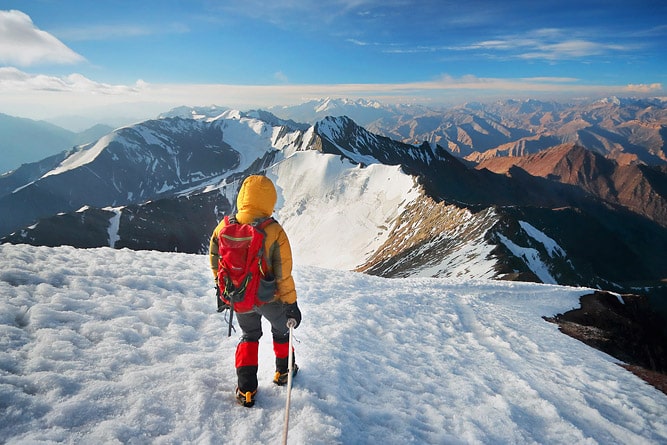
The dramatic peak of Stok Kangri (6,153m) is visible from Leh. The ascent can be done in 4 days from Stok village and it is a relatively easy Himalayan expedition because Stok Kangri is a non-technical peak and it does not require special mountaineering skills. Nonetheless, this is a challenging trek and you should plan for it only if you are in very good physical condition and if you have previous trekking experience at high altitude.
During this trek, you will quickly gain altitude. Therefore, it is essential to be well acclimatized to the altitude before starting the trek. A proper acclimatization is the only way to prevent Acute Mountain Sickness. A good option is to take an extra day for rest and acclimatization at the Base Camp before the summit day.
The trek starts from Stok village, 17 km from Leh. On the first day, the trail follows a gorge and then a valley leading to Mankarmo. The next day, it is a short walk to reach the Base Camp where you should rest and get ready for the final climb. On the 3rd day, you will need to start climbing to the summit very early, before dawn. During the strenuous ascent, you will walk on a glacier so you will have to use ropes, crampons and ice axe. From the summit, you will be rewarded with spectacular views of the Karakoram Range and the Zanskar Range.
Duration:
4 days
Level:
difficult
Max. altitude:
6,153m (at Stok Kangri summit)
Distance:
34 km
Best time:
June to September
Itinerary:
Stok - Mankarmo - Base Camp - Summit - Base Camp - Stok
Transportation before and after the trek:
- Leh to Stok
- Stok to Leh
4. Sham Valley Trek
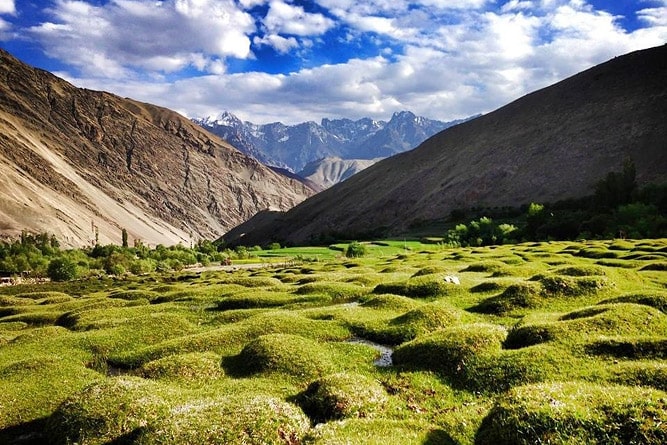
You want to do a trek in Ladakh but you don’t have prior trekking experience?
The Sham valley trek (also known as “baby trek”) is the one for you. Indeed, this is the easiest trek in Ladakh: only 3 days, only 4 hours of walk per day, always below 4,000m altitude. Therefore, this trek is perfect for beginners, for people of average fitness and for those travelling with kids.
The Sham valley trek allows you to discover the magnificent mountains and green valleys of western Ladakh. The trek passes through several villages where you can meet local people and learn about their way of life. You could help the villagers in the fields and stay overnight in traditional Ladakhi houses (homestays).
The trek itinerary starts from Likir village, located 58 km west of Leh. You can visit beautiful Likir monastery before starting the 10-km-hike to Yangthang village where you will spend the first night. On the 2nd day, you will cross the Tsermangchen La pass, the highest point on this trek, before walking down to the charming village of Hemis Shukpachen. On the 3rd day, you will follow a pleasant trail leading to Temisgam where you can visit the palace and monastery.
Duration:
3 days
Level:
easy
Max. altitude:
3,874m (at Tsermangchen La)
Distance:
32 km
Best time:
all year
Itinerary:
Likir - Yangthang - Hemis Shukpachen - Temisgam
Transportation before and after the trek:
- Leh to Likir
- Temisgam to Leh
5. Nubra Valley Trek
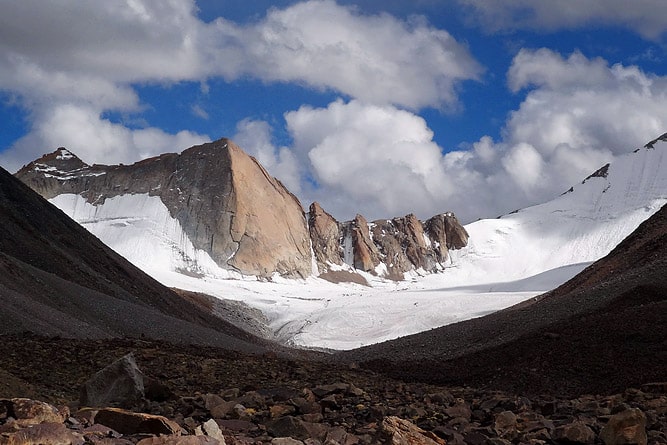
The Nubra valley trek is a 5-day trek from Phyang village (in the Indus valley) to Hunder (in the Nubra valley). The trail follows an ancient trade route which was used by caravans during the old Silk Road days. The highest point on this trek is the Lasermo La pass at an altitude of 5,438m.
Fom Phyang village, located 21 km from Leh, it takes 2 days and half to reach the top of Lasermo La pass which offers unforgettable views of the mountains. Then, the trail goes down to the picturesque Hunder Dok valley covered with meadows and flowers. On the 5th day, you will reach Hunder village and its famous sand dunes.
After the trek, you should take one or two days to visit the main attractions of the Nubra valley before driving back to Leh via the Khardung La pass. This include Diskit monastery, Turtuk village, Panamik hot springs and Samstanling monastery in Sumur.
Duration:
5 days
Level:
moderate
Max. altitude:
5,438m (at Lasermo La)
Distance:
59 km
Best time:
July to September
Itinerary:
Phyang - Phyang Phu - South Base - Lasermo La - North Base - Hunder Dok - Hunder
Transportation before and after the trek:
- Leh to Phyang
- Hunder to Leh
6. Spituk to Stok Trek
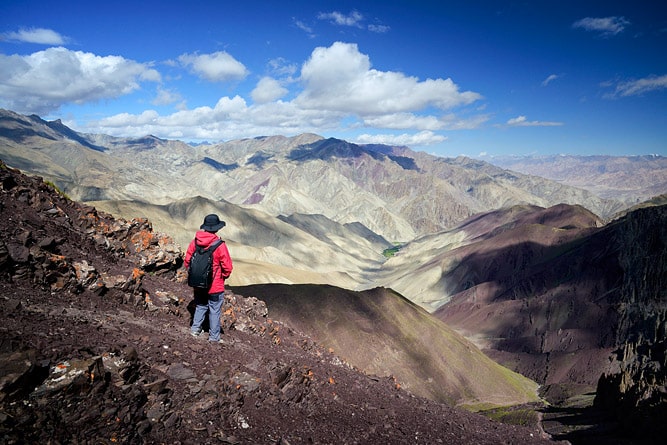
The trek from Spituk to Stok is a wonderful trek in the Hemis National Park, ideal for those who prefer a short trek. In the morning of the first day, you can visit Spituk monastery before starting the trek. The trail follows the Indus river before entering a narrow gorge leading to Zingchen. Zingchen is a nice place to camp. On the next day, it is a short and easy walk to Rumbak village. In the afternoon, you can explore the village and its surroundings. The 3rd day is more difficult. It starts with a 3-hour ascent of Stok La pass at 4,855m altitude. From the top of the pass, you will enjoy the breathtaking panorama. Then, it is a long walk down to Stok village. In Stok, you can visit the palace before heading back to Leh.
Duration:
3 days
Level:
easy to moderate
Max. altitude:
4,855m (at Stok La)
Distance:
39 km
Best time:
June to October
Itinerary:
Spituk - Zingchen - Rumbak - Stok
Transportation before and after the trek:
- Leh to Spituk or Zingchen
- Stok to Leh
7. Lamayuru to Alchi Trek
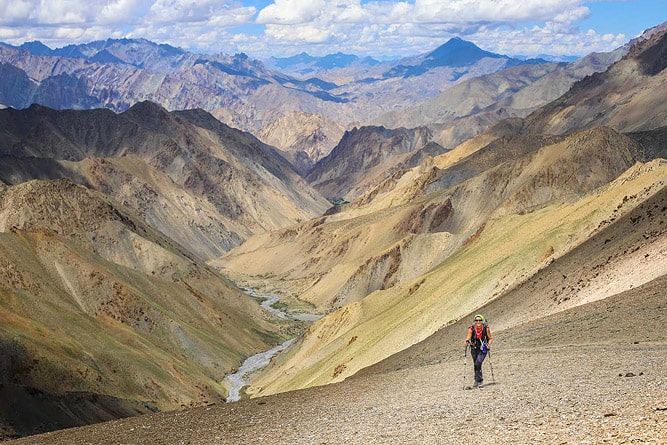
The trek from Lamayuru to Alchi is a difficult trek with two challenging mountains passes: Kongskil La (4,948m) and Stakspi La (5,153m). The itinerary passes through remote villages surrounded by barley fields where you can meet villagers and discover the Ladakhi culture. Homestays are available in most of the villages such as Wanla, Hinju and Sumda Choon.
The trek connects two of the most famous monasteries of Ladakh: Lamayuru gompa perched above a medieval village and Alchi gompa which is well known for its extraordinary ancient murals. During the trek, on the 4th day, you will visit Sumda Choon monastery, one of the oldest gompas in Ladakh. Before and after the trek, you can also visit other monasteries in the area such as Basgo, Rizong and Likir and maybe attend a festival.
While the two first days and the 4th day of the trek are quite easy, the 2nd and 5th days are very difficult with more than 1,200m elevation gain and 8 hours walk each day. This is because of these two demanding days that the trek from Lamayuru to Alchi is rated as difficult.
Duration:
5 days
Level:
difficult
Max. altitude:
5,153m (at Stakspi La)
Distance:
71 km
Best time:
June to October
Itinerary:
Lamayuru - Wanla - Hinju - Sumda Chenmo - Sumda Choon - Alchi
Transportation before and after the trek:
- Leh to Lamayuru
- Alchi to Leh
8. Snow Leopard Trek
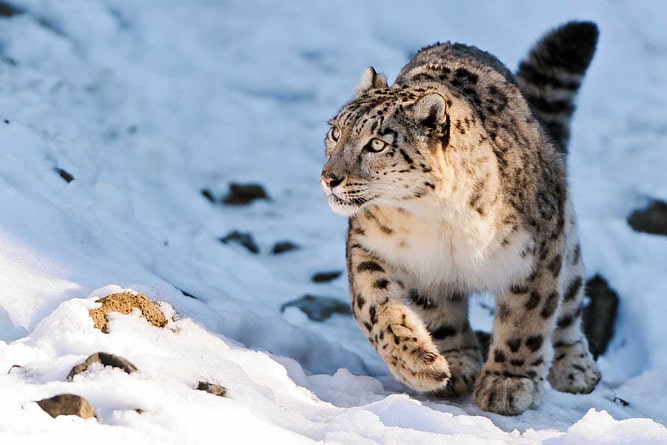
The snow leopard, known as schan in Ladakhi, is one of the most elusive mammals in the Himalayas. Snow leopards can be found in Ladakh and the Hemis National Park is the best place to spot them. The best time to observe snow leopards is in February and March. Indeed, during these months, the snow leopards descend to lower altitude in search of food and there is a higher chance to spot them is the valleys. February and March is also the mating season for snow leopards.
The Snow Leopard trek starts from Spituk and it takes 2 days to reach the village of Rumbak, located at an elevation of 3,970m in the Hemis National Park. During the next few days, you will stay in Rumbak area and follow your expert guide to maximize your chances of spotting the magnificent cat. The Hemis National Park is also home to other animals such as Tibetan wolves, Asiatic ibex, red foxes, bharals and Ladakh urials. Many species of birds can also be seen such as golden eagles and vultures.
Wildlife watching takes patience, luck and persistence; especially with the harsh weather conditions of the Ladakhi winter. However, spotting the snow leopard and other animals in their natural habitat is an experience that you will never forget!
Duration:
approximately 8 days
Level:
easy
Max. altitude:
3,970m (at Rumbak)
Distance:
29 km
Best time:
February & March
Itinerary:
Spituk - Zingchen - Rumbak - Rumbak area - Rumbak - Zingchen - Spituk
Transportation before and after the trek:
- Leh to Spituk or Zingchen
- Spituk or Zingchen to Leh
9. Chadar Trek (Frozen Zanskar River)
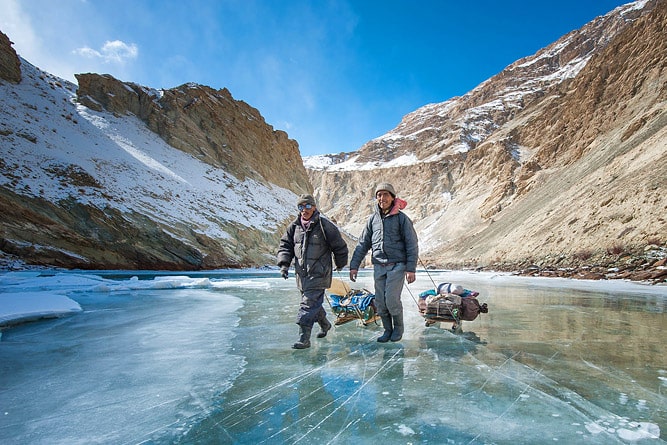
The Chadar trek is a very unique winter trek on the frozen Zanskar river. This path on the frozen river is the only way for the Zanskari people to access the rest of the country because all the roads to the remote Zanskar region are closed in winter due to heavy snowfall. The trek is usually possible in January and February (although the global warming has had an impact on the ice thickness during the last winters).
The Chadar trek starts from Chilling village and it takes 4 days walking on the ice along narrow gorges to reach Lingshed, one of the main villages in Zanskar. During the trek, you will spend the nights in caves along the river. Be ready to face extreme cold temperatures, as low as -25 to -35 degrees during the night. The way back to Chilling and Leh is done through the same way.
Duration:
9 days
Level:
easy to moderate
Max. altitude:
3,882m (at Lingshed)
Distance:
54 km
Best time:
January & February
Itinerary:
Chilling - Zari Bago - Dib Yokma - Nyerak Pulu - Lingshed - Nyerak Pulu - Dib Yokma - Zari Bago - Chilling
Transportation before and after the trek:
- Leh to Chilling
- Chilling to Leh
10. Saboo to Khalsar Trek
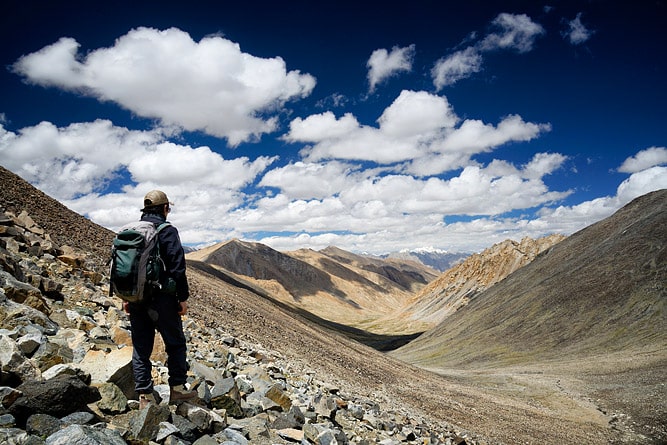
The trek from Saboo to Khalsar is an alternative to the Nubra valley trek from Phyang to Hunder. Indeed, these two treks are very similar in term of duration, difficulty, distance, elevation, landscape… Though the trek from Saboo to Khalsar is slightly more difficult because the Digger La pass is crossed on the 2nd day (whereas the Lasermo La pass is crossed on the 3rd day on the Phyang to Hunder trek).
When you reach Khalsar village in the Nubra valley, it is recommended to keep some time to visit the main highlights of this part of Ladakh (e.g. Diskit, Sumur, Hunder, Panamik, Turtuk) before heading back to Leh.
Duration:
5 days
Level:
moderate
Max. altitude:
5,405m (at Digger La)
Distance:
59 km
Best time:
July to September
Itinerary:
Saboo - Digger La Base - Digger La - Chumik Yokma - Digger - Rongjok - Khalsar
Transportation before and after the trek:
- Saboo is only 5 km from Leh, you could go there on foot or with a local taxi
- Khalsar to Leh
